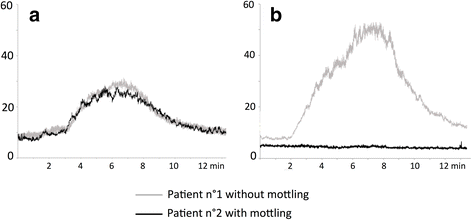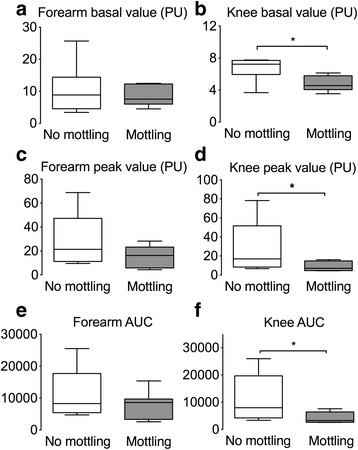Marked regional endothelial dysfunction in mottled skin area in patients with severe infections
- PMID: 28641580
- PMCID: PMC5481873
- DOI: 10.1186/s13054-017-1742-x
Marked regional endothelial dysfunction in mottled skin area in patients with severe infections
Abstract
Background: Mottling around the knee, reflecting a reduced skin blood flow, is predictive of mortality in patients with septic shock. However, the causative pathophysiology of mottling remains unknown. We hypothesized that the cutaneous hypoperfusion observed in the mottled area is related to regional endothelial dysfunction.
Methods: This was a prospective, observational study in a medical ICU in a tertiary teaching hospital. Consecutive adult patients with sepsis admitted to ICU were included. After resuscitation, endothelium-dependent vasodilation in the skin circulation was measured before and after iontophoresis of acetylcholine (Ach) in the forearm and the knee area. We analyzed the patterns of induced vasodilatation according to the presence or absence of mottling and vital status at 14 days.
Results: We evaluated 37 septic patients, including 11 without and 26 with septic shock. Overall 14-day mortality was 22%. Ten patients had mottling around the knee (10/37, 27%). In the knee area, the increased skin blood flow following iontophoresis of Ach was lower in patients with mottled skin as compared to patients without mottled skin (area under curve (AUC) 3280 (2643-6440) vs. 7980 (4233-19,707), both P < 0.05). In the forearm area, the increased skin blood flow following iontophoresis of Ach was similar in patients with and without mottled skin. Among patients with septic shock, the increased skin blood flow following iontophoresis of Ach in the knee area was significantly lower in non-survivors as compared to survivors at 14 days (AUC 3256 (2600-4426) vs. 7704 (4539-15,011), P < 0.01). In patients with septic shock, the increased skin blood flow in the forearm area following iontophoresis of Ach was similar in survivors and non-survivors at 14 days.
Conclusion: Mottling is associated with regional endothelial dysfunction in patients with septic shock. Endothelial dysfunction in the knee skin area was more pronounced in non-survivors than in survivors.
Keywords: Endothelial function; Infection; Mortality; Mottling; Tissue perfusion.
Figures





References
-
- Trzeciak S, Dellinger RP, Parrillo JE, Guglielmi M, Bajaj J, Abate NL, Arnold RC, et al. Early microcirculatory perfusion derangements in patients with severe sepsis and septic shock: relationship to hemodynamics, oxygen transport, and survival. Ann Emerg Med. 2007;49(1):88–98. doi: 10.1016/j.annemergmed.2006.08.021. - DOI - PubMed
Publication types
MeSH terms
LinkOut - more resources
Full Text Sources
Other Literature Sources
Molecular Biology Databases

